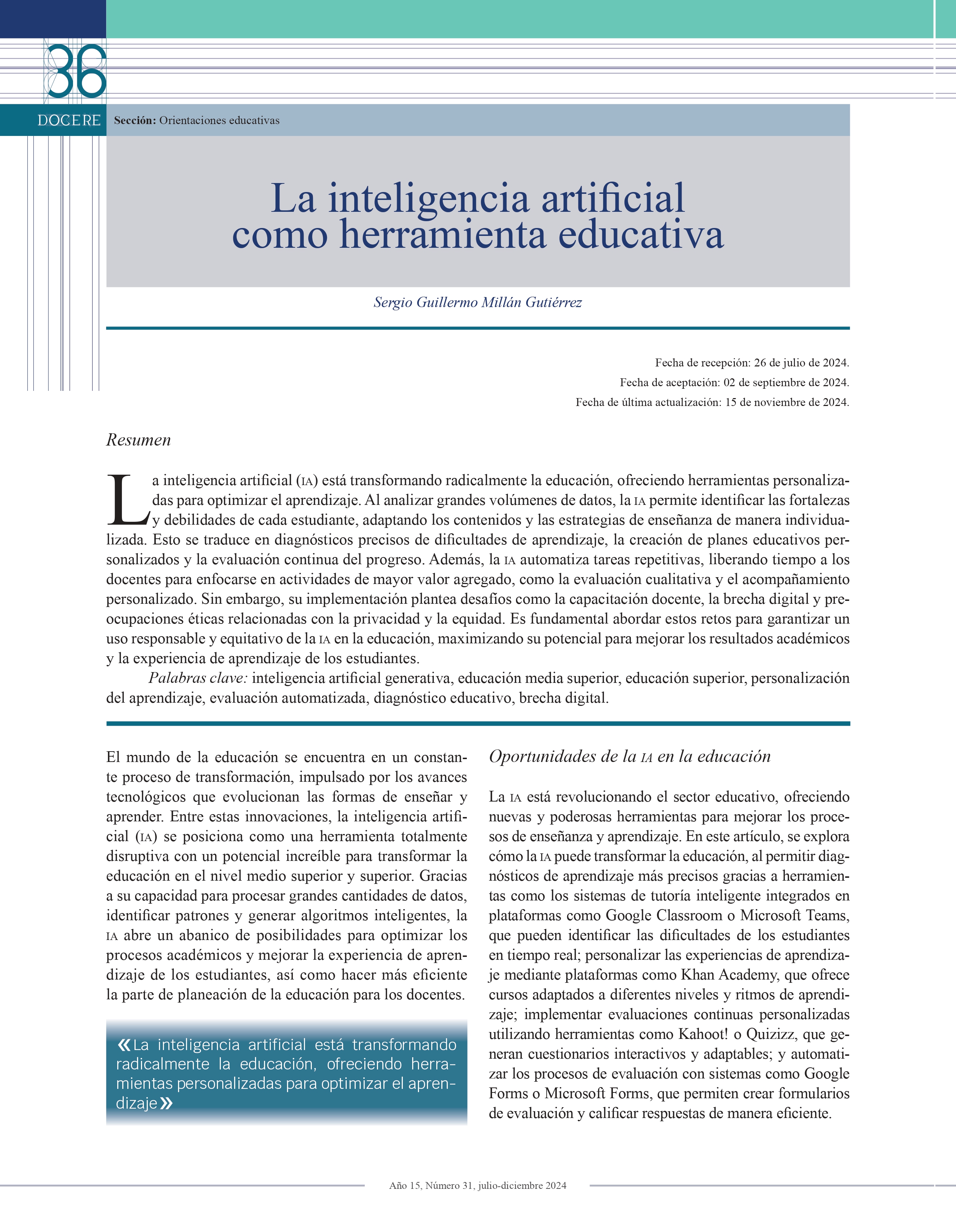Artificial Intelligence as an Educational Tool
DOI:
https://doi.org/10.33064/2024docere317861Keywords:
generative artificial intelligence, upper secondary education, higher education, learning personalization, automatized assessment, educational diagnostic, digital divideAbstract
Artificial Intelligence (AI) is transforming education radically, offering personalized tools to optimize learning. When analyzing big amounts of data, AI allows to identify the strengths and weaknesses of each student, adapting the contents and the teaching strategies individually. This translates to precise diagnosis of learning difficulties, the creation of personalized curricula and the continuous assessment of progress. Moreover, AI automatizes repetitive tasks, allowing teachers to dedicate more time to higher-value activities, such as qualitative assessment and personalized guidance. However, the implementation of the AI implies challenges such as the teaching training, the digital divide, and ethical worrying related to the privacy and equity. It is fundamental to address these challenges to guarantee a responsible use of AI in education, maximizing its potential to improve the academic results and the experience of students learning.
Translated by: Adán Israel Vázquez Alba.
Downloads
References
Brown, L. (2019). Personalized learning: The role of AI in education. Journal of Educational Technology, 15(2), 45-58. https://doi.org/10.1234/edtech.2019.15204.
Crawford, K., Whittaker, M., Elish, M. C., Barocas, S., Plasek, A. & Ferryman, K. (2016). The AI now report: The social and economic implications of artificial intelligence technologies in the nearterm. AI Now Institute. https://ainowinstitute.org/AI_Now_2016_Report.pdf.
Díaz, M. (2020). Immediate feedback mechanisms in AI-driven learning environments. International Journal of Learning Technologies, 22(3), 67-83. https://doi.org/10.5678/ijlt.2020.22307.
Fernández, P. (2019). Evaluating student progress with AI tools. Educational Assessment Review, 28(4), 99-115. https://doi.org/10.8765/edassessrev.2019.28409.
Floridi, L., Cowls, J., Beltrametti, M. et al. (2018). AI4People: An ethical framework for a good AI society: Opportunities, risks, principles, and recommendations. Minds & Machines, 28, 689-707 (2018). https://doi.org/10.1007/s11023-018-9482-5. DOI: https://doi.org/10.1007/s11023-018-9482-5
García, R. (2018). AI and early detection of learning difficulties. Journal of Innovative Education Strategies, 11(1), 23-40. https://doi.org/10.3456/jies.2018.11015. DOI: https://doi.org/10.55777/rea.v11i22.1080
Johnson, K. (2020). Identifying strengths and weaknesses in students using AI. Educational Data Science, 7(2), 120-135. https://doi.org/10.2345/edsci.2020.70212.
Morales, A. (2021). Addressing the digital divide in AI-enhanced education. Technology in Education Journal, 14(1), 56-72. https://doi.org/10.9876/techinedu.2021.14105.
Parlamento Europeo y Consejo de la Unión Europea. (2016). Reglamento (UE) 2016/679 del Parlamento Europeo y del Consejo del 27 de abril de 2016 relativo a la protección de las personas físicas en lo que respecta al tratamiento de datos personales y a la libre circulación de estos datos (Reglamento General de Protección de Datos). Diario Oficial de la Unión Europea, L119, 1-88. https://eur-lex.europa.eu/legal-content/ES/TXT/?uri=CELEX-%3A32016R0679.
Smith, J. & Doe, A. (2021). AI recommendations for targeted educational resources. Advances in Learning Technologies, 19(3), 88-101. https://doi.org/10.4321/advlearntech.2021.19311.
UNESCO (2021). Ethical guidelines for ai in education. UNESCO Publications. https://unesco.org/ethicalguidelinesai.
Universidad Autónoma de Aguascalientes (UAA). (2024). Guía básica para docentes de la UAA 2024. https://acortar.link/aQHZZU.
Williams, R. (2021). Interactive learning through ai-generated activities. Journal of ai in Education, 10(4), 77-90. https://doi.org/10.5432/jai.education.2021.10409.

Downloads
Published
How to Cite
Issue
Section
License
Esta obra está bajo una Licencia Creative Commons Atribución-NoComercial-CompartirIgual 4.0 Internacional.
El lector y/o usuario que utilice el material publicado en la revista DOCERE de la Universidad Autónoma de Aguascalientes, deberá en todos los casos: a) Reconocer la autoría del material utilizado, proporcionando un enlace a la licencia, además de indicar sí se han realizado cambios al material; b) Queda prohibido utilizar el material proveniente de la revista DOCERE, con finalidad comercial y, C) En los casos en los que se realice la remezcla, transformación o creación, a partir del material publicado de la revista DOCERE, se deberá dar reconocimiento de los derechos que correspondan a la Universidad Autónoma de Aguascalientes, en su carácter de titular de la materia protegible utilizada. En caso de infracción a lo antes dispuesto, el lector y/o usuario, se hará acreedor a las sanciones que establece la legislación de la materia.












